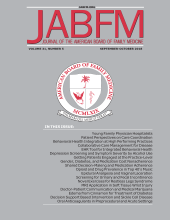Article Figures & Data
Tables
- Table 1. Sample Sociodemographic Characteristics of Participants at Teaching and Nonteaching Sites
Characteristics Participants With Characteristic Teaching Site (n = 975) Nonteaching Site (n = 777) Age (years) 18–34 282 (29) 109 (14) 35–54 335 (∼34) 242 (31) 55–74 278 (28.5) 353 (∼45) Missing data* (n = 153) 80 (∼8.5) 73 (∼10) Sex Female 697 (71.5) 481 (62) Male 201 (20.5) 215 (∼28) Missing data† (n = 158) 77 (8) 81 (∼10) Race White 86 (∼9) 94 (12) Black 364 (∼37) 337 (∼43) Asian 14 (∼1.5) 13 (∼1.5) Native Hawaiian/Pacific Islander 7 (∼0.5) 2 (0.25) American Indian/Alaskan Native 5 (5) 3 (∼0.25) Other 300 (∼31) 161 (∼21) Multiracial‡ 24 (2.5) 13 (∼1.5) Missing data§ (n = 353) 175 (∼14) 178 (∼20.5) Latino 457 (∼49) 262 (∼34) Language of survey Spanish 213 (∼22) 19 (∼2.5) English 762 (∼78) 758 (∼97.5) Insurance payer Straight Medicaid 56 (∼5.5) 15 (∼2) Medicaid managed care 491 (∼50.5) 171 (22) Medicare 14 (∼1.5) 16 (2) Medicaid and Medicare 4 (∼0.5) 4 (0.5) Private 198 (∼20) 426 (∼55) Self-pay 43 (4.5) 3 (∼0.5) Other 24 (2.5) 16 (2) Don't know 13 (∼1.5) 8 (1) Missing data‖ (n = 250) 132 (∼13.5) 118 (∼15) Education Less than high school 228 (∼23) 79 (10) High school education or more 647 (∼66) 611 (∼79) Missing data¶ (n = 187) 100 (∼11) 87 (∼11) Data are n(%).
↵* Total missing data for age range are < 9%.
↵† Total of 9% are missing data for sex.
↵‡ Multiracial refers to participants who chose more than one race as an identifier (excludes the category of “other”).
↵§ Total of 21% missing data for race.
↵‖ Total of 14% missing data for insurance payer.
↵¶ Total of 10.5% missing data for education.
Experiences by Survey Adjusted Mean Score (95% CI)* Adjusted Mean Difference Between Teaching and Nonteaching Sites (95% CI) P Value Teaching Sites Nonteaching Sites CAHPS subscales† Access to care (n = 846) 4.35 (3.78–4.92) 5.14 (4.47–5.81) −0.79 (−1.36 to −0.22) .01 Provider communication (n = 1356) 5.60 (5.44–5.76) 5.52 (5.17–5.86) 0.08 (−0.08 to 0.24) .33 Clerk/receptionist courtesy (n = 1364) 5.20 (4.66–5.29) 5.52 (4.94–6.10) −0.32 (−0.86 to 0.23) .25 PACIC total score and subscales‡ Total chronic disease score (n = 848) 4.02 (3.84–4.20) 3.79 (3.24–4.33) 0.23 (0.05–0.41) .01 Patient activation (n = 850) 4.26 (4.05–4.46) 3.81 (3.19–4.43) 0.45 (0.24–0.65) <.001 Delivery system (n = 841) 4.39 (4.20–4.59) 4.34 (3.76–4.91) 0.05 (−0.14 to 0.25) .60 Goal setting (n = 892) 3.85 (3.65–4.05) 3.65 (3.05–4.25) 0.20 (−0.001 to 0.40) .051 Problem solving (n = 800) 4.36 (4.14–4.58) 4.06 (3.38–4.74) 0.30 (0.08–0.52) .01 Follow-up/coordination (n = 874) 3.59 (3.39–3.80) 3.36 (2.75–3.97) 0.23 (0.03–0.44) .03 Bold values indicate statistically significant results.
↵* All values are adjusted for age, sex, education, overall health status, race, ethnicity, survey language, and insurance payer.
↵† Scores range from 1 to 6. Higher scores indicate a more favorable patient experiences.
↵‡ Scores range from 1 to 5. Higher scores indicate a more favorable patient experiences.
CAHPS, Consumer Assessment of Health care Providers and Systems; CI, confidence interval; PACIC, Patient Assessment of Chronic Illness Care.







